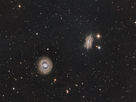Caroline's Rose - Open Cluster with IFN in Cassiopeia Astrophotography
- Antoine & Dalia Grelin
- Jun 9
- 3 min read
Updated: Jun 13
Caroline's Rose is a beautiful open cluster located in the constellation Cassiopeia. It is in a region of the sky rich in stars and interstellar dust.
Object Designation: NGC 7789
Also Known As: Caroline's Rose Cluster
Constellation: Cassiopeia
Object Type: Open Cluster
Distance: 7,600 light-years away
Magnitude: 6.7
Discovery: 1783 by Caroline Herschel
NGC 7789 is a dense and highly populated open cluster that is home to thousands of stars. It has a magnitude of 6.7, and can be seen with binoculars if you are under dark enough skies. It looks much better through a telescope, with many individual stars visible.
In the Northern Hemisphere, Caroline’s Rose is best observed and photographed in the Fall and early Winter months, when Cassiopeia is high in the night sky.
Click the picture to see it in high resolution!
GEAR USED:
Camera: ZWO ASI2600MC
Telescope: Celestron RASA 8
Mount: 10Micron GM2000 HPS
Accessories: Celestron Focuser / PrimaLuceLab Eagle 5S
Processing: Pixinsight, with R-C Astro plugins. Final touches in Skylum Luminar Neo
ACQUISITION DETAILS:
Total Exposure Time: 6 hours
Exposure Time per frame: 600 seconds
Filters: N/A
Gain: 100
How to Locate Caroline's Rose

To find Caroline’s Rose, first spot the “W” shape of the constellation Cassiopeia. This pattern is easy to spot because the stars making up the "W" are so bright. Once found, look for the bright star Beta Cassiopeiae (Caph) on the western end of the “W.” From Caph, go westward and you might land on Caroline’s Rose, which lies just a few degrees southwest of Rho Cassiopeiae.
Caroline's Rose is not far from other popular deep sky objects, like the Bubble Nebula (with M52), the Andromeda Galaxy, M103, as well as the Heart and Soul Nebulae.
Learn Astrophotography with the Galactic Course
Want to learn how to capture deep sky objects, the Milky Way, and more? Join the Galactic Course to have access to all our astrophotography courses, as well as all our processing guides!

Get courses and processing tutorials individually, or sign up for a bundle to get access to it all!
Single Shot & Processing of NGC 7789
I decided to aim at Caroline's Rose at random as a secondary target. I knew that this target was a beautiful star cluster, and I always liked the nickname, but never really thought of imaging it. I am happy I spent 6 hours on it as I feel it is a sweet number of hours to get something beautiful and clean in a single night. Below is what the stacked result looked like before processing!

Processing this cluster was not too difficult. I specifically wanted to reveal any IFN present around the field of view, but couldn't see any on both the single files or the stacked file. The IFN only started popping up when I started to process the data, specifically after doing a gradient correction, and much more once I permanently stretched the image.
Overall, it was easy once I removed the stars and could work on the IFN, although I honestly barely had to edit it, as I didn't want to make it too strong and unnatural.
This data, along with a ton of others, can be downloaded from the Raw Data Pack of the Galactic Course.
Final Thoughts
NGC 7789 is a fun target to shoot! The cluster itself is beautiful, and the stars around it are bright and make the entire image look nice. This target is even more interesting if you try going for the IFN present nearby. You'll need to spend several hours to get the faint clouds showing, but you can see that 6 hours from a dark site is enough to get a very nice result! Of course, since we're talking about IFN, you can always triple or quadruple your total integration time to get something even more impressive.
Have you captured Caroline's Rose? Show us your image in the comments below!
Clear Skies,
Galactic Hunter
ASTROPHOTOGRAPHY TUTORIALS























